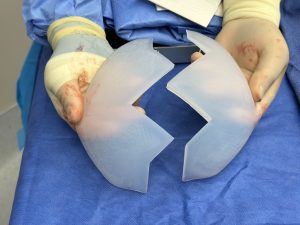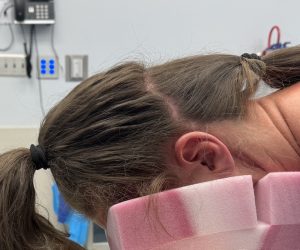Background: The desire for aesthetic skull augmentation can be for multiple skull shape concerns. In females one of the most common is for an increased crown of the head height. There is often a predicate history of hairstyle methods to increase the appearance of the crown of head height, which can be successful, but involves a lot of work/time on a daily basis and adds up over the years. There are even non-surgical devices to create it (Bumpit) which has its limitations.
A custom skull implant provides the definitive solution for crown of the head augmentation but its success depends on having enough implant volume (size) to do so. The implant volume needed depends on how much crown height is needed from ‘just a little’ to ‘a lot’. Those verbal descriptions have to be translated into a visual understanding which is done by computer imaging (Photoshop) of potential crown of head augmentations done in profile.
But besides the imaged change in crown of head height a judgement is also required of how much the patient’s scalp can stretch to safely accommodate the implant size. In thinner scalps with larger implant volumes a first stage scalp expansion is needed.








All custom skull implants to be successful (surgical placement and postoperative tissue tolerance) require stretch of the scalp over it. If the scalp stretch is inadequate postoperative complications such as wound dehiscence, shock hair loss and infection can occur due to diminished blood flow into the overlying scalp.
Judging the stretch of the scalp is not an exact science nor is knowing how much implant volume that can be tolerated. But a lot of experience has taught me that how much the scalp can stretch is a function of its thickness which varies considerably based on gender, skin pigmentation and hair color. As a general rule thin Caucasian females with blonde or light brown hair have very thin scalps with limited stretch capability. Unless only a very small implant volume is needed (under 100ccs) these patients require a first stage scalp expansion which completely avoids all the aforementioned potential complications.
Key Points:
1) Larger skull implants in thin female scalps with little flexibility require a first stage scalp expansion.
2) A first stage scalp expansion volume should equal rot be greater than that of the custom skull implant design.
3) To keep the scalp incision limited large custom skull implants are designed in split pieces to be inserted separately and reassembled once inside the implant pocket.
Dr. Barry Eppley
World-Renowned Plastic Surgeon






